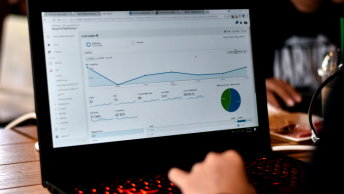Whether you have a website, application, or piece of online media, you need to see if visitors are engaged with your digital brand. This article outlines 10 engagement metrics you should be tracking.
If you’re looking for a starting point for developing engagement metrics, then this list is for you.
(First, you need a Google Analytics account. If you do not have one, click here for more information.)
1. Time to Start Render
This metric indicates the beginning of a user’s engagement with a web page. It is measured by the elapsed time from when the browser requests a web page to the moment when content appears in the browser. Improving Time to Start Render allows you to engage with users faster and, in turn, they will be far less likely to bounce away from the page.
One additional second increases bounce rate by 65%
How to Analyze Effectively
You can use this website test to conduct a series of tests on a number of different pages on your site. Remember, the faster your website loads the better.
To benchmark, the Internet-wide average is 2.5 seconds. However, the top 10% of sites on the web for this metric have start times under one second.
2. Time to Display
Time to Display indicates that time until the user can engage with a page (even if all page elements have not been processed). The faster you can get crucial content in front of them, the less chance of abandonment. Improving this metric is key as this adds to the user’s perceived usability of the page.
How to Analyze Effectively
Similar to Time to Start Render, use this tool to conduct a series of tests on a number of different pages on your site. The average site on the web has a Time to Display of just over 5 seconds. However, the fastest sites are around 2 seconds.
3. Time to Interact
Time to Interact is measured by the time from when the browser requests a web page to the moment the user can fully engage every on-page event. This metric is important as users may not be able to use all the features on your site. Personally, I have witnessed a longer Time to Interact when I have several widgets installed on this blog (But hopefully that problem is resolved. If not let me know.)
How to Analyze Effectively
You can analyze this effectively by visiting your site from multiple devices and browsers, and connection speeds. For instance, try your mobile phone, your home and work Internet.
The Internet-wide median for Time to Interact is over 6 seconds. The fastest sites are around 2.8 seconds.
4. Bounce Rate
The bounce rate is the percentage of users that visit only one page before exiting your site. It is important to note that your website design and performance can greatly affect your bounce rate. Try to understand what’s most important to your visitors and give it to them right away. Your sales and/or leads depend on it!
Remember, having a poor Time to Start Render and Time to Display can greatly affect your bounce rate. In this case, your website is generating bad user experiences and must be updated. Additionally, if you have implemented any SEO strategies on your site, be sure that you are using the correct keywords and meta descriptions for SEO. Nothing says “BOUNCE” like when you arrive at a website about apples when you’re looking for oranges.

How to Analyze Effectively
Using Google Analytics is a great way to determine your bounce rate. If you notice peaks and valleys in your bounce rate, whether frequent or occasional, they are typically indicators of problems with Time to Start Render, Time to Display, or Time to Interact.
Bounce rates are difficult to measure and vary among different types of sites. For instance, on eCommerce product category pages, the bounce rate is under 20% and over 80% on “Contact Us” pages.
5. Time on Site
Time on site measures the duration of a visitor session, starting from the moment a visitor lands on the site to the moment the visitor leaves. On sites like blogs, ecommerce, and news media, more time spent on site is usually an indicator that users are pleased and engaging with the content. If you notice users are leaving quickly, you may want to update your content or provide a better user experience.
How to Analyze Effectively
Look for peaks and valleys but remember this metric may be driven by user behavior. For instance, you may find a longer Time on Site for users during the day than at night.
6. Pages Per Visit
This metric measures the number of pages visited during a visitor session. It is an indication of how successful your pages are at maintaining a visitor’s focus and attention. Remember, bored visitors leave; those who stay are highly engaged with your content and choose to view more pages.
How to Analyze Effectively
It makes sense to analyze this metric the way you would Time on Site. Naturally, both of these metrics should rise and fall together. If not then dig into visitor flows to find out what your users are doing.
7. Conversion Rate
This metric is my favorite and is very important in digital marketing. A Conversion Rate is generally defined as the percentage of visitors to a website that “converted” by a desired activity such as making a purchase or filling out a form.
This metric is important as it is the culmination of one major stage of engagement: the user has been adequately convinced by your site’s offerings to spend time, and/or money to convert.

How to Analyze Effectively
Under your Google Analytics account go to Conversions > eCommerce. Although this requires additional steps, it will definitely benefit you in the long run. Conversion rates generally fluctuate since they are affected by site content changes and/or marketing campaigns.
Thought leaders generally speak of a site generating a 2% conversion rate or above 1% for eCommerce sites. If you find your conversion rate being lower than 2%, then there are likely step you can take to improve it.
8. Abandonment Rate
Abandonment Rate is the percentage of visits that initiated some conversion activity on your site but did not finish that activity. This metric is interesting as it indicates the perceived difficulty of a task and the amount of effort the users assumes will be required to complete that task. High abandonment rates are often attributed to user experience and design features, performance problems, and unclear messaging (especially in product or check out pages).

How to Analyze Effectively
You must set up “Goals” in Google Analytics. Once set up, you can dive into this metric the same way you do conversion rate: charting the changes by time increment and comparing it against fluctuation in traffic.
For eCommerce sites, abandon rates are high with 75% being the Internet average.
9.Order Value
Order value measures the average monetary value per customer who made a purchase or transaction on the site. The formula is:
revenue generated / number of orders taken
This metric is key for eCommerce sites as it indicates how well your site convinced a visitor to purchase.
Increasing order value is typically accompanied by an increase in conversion rate.

How to Analyze Effectively
Average order value is a standard eCommerce metric and typically, no additional configuration is needed.
10. Revenue
When you consider ways in which you can improve your site, you must consider revenue as a metric. If you use your site to simulate revenue understand how these other nine metrics contribute to your bottom line. Know that higher abandonment rate can lower conversion rate; longer Time to Start Render can increase bounce rate and abandonment, and decrease order value; and longer Time to Display can reduce average order value. In one way or another, each of these metrics affects revenue and your site’s potential for profit.
The reason I include revenue here is to drive home the point that your site’s performance in all of the metrics on this list can and do influence revenue, and should be taken seriously.
What engagement metrics are you using to increase revenue?
Benchmarking source: http://www.apqc.org/benchmarking-portal









